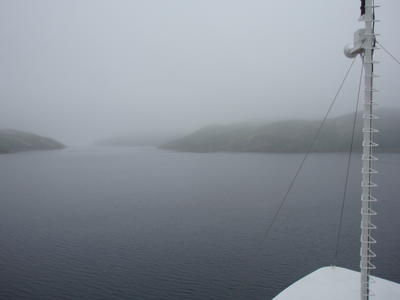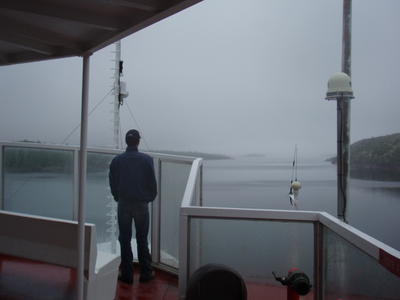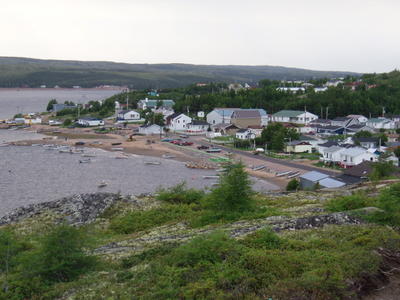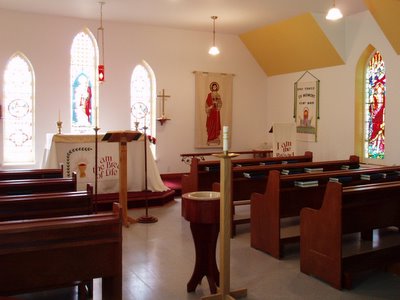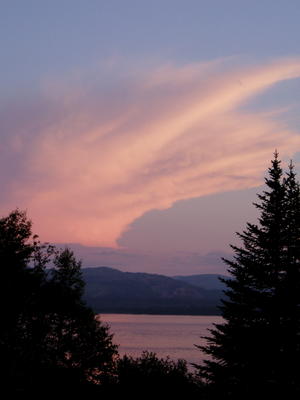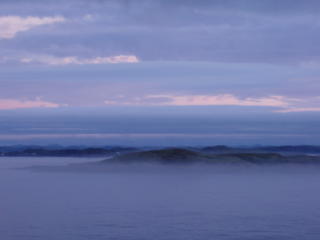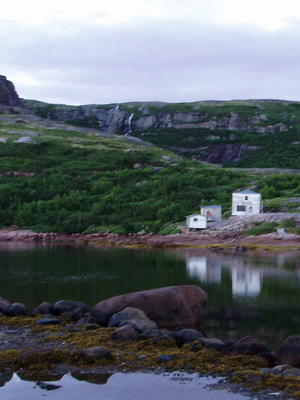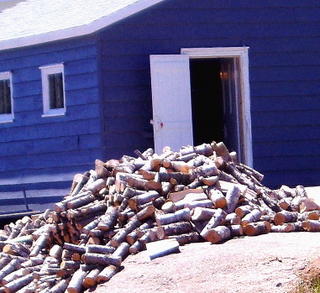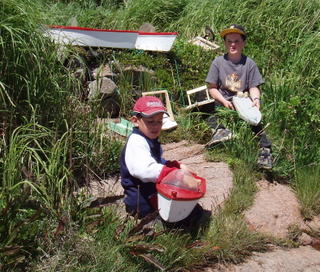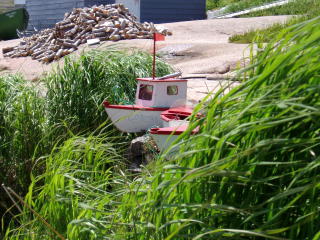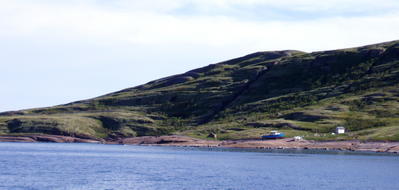Friday, July 29, 2005
Thursday, July 28, 2005
A remote island home in the archipelago off St. Augustine. Is it abandoned or was it simply not in use at the time we passed? There was no way to tell, but there was certainly no sign of human occupation. It seems almost inconceivable to me that anyone could live in such remote conditions, on a small island about an hour by boat from the nearest community. They did, however, at some time in the past, and they were not the only ones: we passed a number of similar, apparently abandoned homes.

As the fog began to lift, we could see more detail in the islands of the archipelago.


As the fog began to lift, we could see more detail in the islands of the archipelago.

Thursday, July 14, 2005
Whale Watching

When planning for the summer on the Lower North Shore, there were two things in particular to which I looked forward with special anticipation - one was the opportunity to see puffins and the other was to go whale watching. To date the puffins remain elusive. Little did I expect, however, not only to see whales at a respectful distance, but to be able to watch one, a Beluga, up close and for an extended period of time.
Last Friday Randy took the Nordik down the coast to St. Augustine. When we arrived at the wharf in La Tabatière, there was a little buzz about a whale that had been spotted in the harbour. As we scanned the water in the bay, people suddenly began to rush to the end of the wharf. We followed, in time to see a white whale surface briefly and blow a short distance off. Then almost immediately, there it was, beneath our feet, swimming just below the surface along the edge of the wharf. It continued for more than half an hour to swim back and forth from one side of the wharf to the other, passing around and under the boats tied up there.
I was surprised at what a thrill it was to watch -- so brilliantly snow white, so utterly at home in its environment, so beautifully formed, and so consumately graceful in all its movements. It seemed to communicate a sense of innocent joy in being able to please the knot of excited children and adults peering over the edge of the wharf.

These creatures, as I've since learned, are both playful and very curious. The younger ones in particular delight in investigating and interacting with humans. On this occasion, one of the local sailors jiggled a rope in the water. Immediately the Beluga responded: in one fluidly effortless, unhurried motion it rolled over, turned, and came over to investigate. I was captivated.

When planning for the summer on the Lower North Shore, there were two things in particular to which I looked forward with special anticipation - one was the opportunity to see puffins and the other was to go whale watching. To date the puffins remain elusive. Little did I expect, however, not only to see whales at a respectful distance, but to be able to watch one, a Beluga, up close and for an extended period of time.
Last Friday Randy took the Nordik down the coast to St. Augustine. When we arrived at the wharf in La Tabatière, there was a little buzz about a whale that had been spotted in the harbour. As we scanned the water in the bay, people suddenly began to rush to the end of the wharf. We followed, in time to see a white whale surface briefly and blow a short distance off. Then almost immediately, there it was, beneath our feet, swimming just below the surface along the edge of the wharf. It continued for more than half an hour to swim back and forth from one side of the wharf to the other, passing around and under the boats tied up there.
I was surprised at what a thrill it was to watch -- so brilliantly snow white, so utterly at home in its environment, so beautifully formed, and so consumately graceful in all its movements. It seemed to communicate a sense of innocent joy in being able to please the knot of excited children and adults peering over the edge of the wharf.

These creatures, as I've since learned, are both playful and very curious. The younger ones in particular delight in investigating and interacting with humans. On this occasion, one of the local sailors jiggled a rope in the water. Immediately the Beluga responded: in one fluidly effortless, unhurried motion it rolled over, turned, and came over to investigate. I was captivated.
Wednesday, July 13, 2005
Ain't a-gonna need this house no longer
ain't a-gonna need this house no more
Ain't got time to fix the shingles
Ain't got time to fix the floor
Ain't got time to oil the hinges
Nor to mend the window pane
Ain't a-gonna need this house no longer
I'm a-gittin' ready to meet the Saints.
This old house once knew my children
This old house once knew my wife,
This old house was home and comfort as we fought the storms of life
This old house once rang with laughter
This old house heard many shouts
Now it trembles in the darkness as the night wind walks about
ain't a-gonna need this house no more
Ain't got time to fix the shingles
Ain't got time to fix the floor
Ain't got time to oil the hinges
Nor to mend the window pane
Ain't a-gonna need this house no longer
I'm a-gittin' ready to meet the Saints.
This old house once knew my children
This old house once knew my wife,
This old house was home and comfort as we fought the storms of life
This old house once rang with laughter
This old house heard many shouts
Now it trembles in the darkness as the night wind walks about
Almost every home has at least one shed and a woodpile. The sheds are used for storage and as workshops. (I've yet to see a garage, and basements are minimal, if present at all.)
Woodpiles are normally very neatly arranged on stages or directly on the rock. This one appears to have started out that way but to have suffered some misadventure.
The shed here is owned by our neighbour across the road. Recently her grandsons visited for a couple of weeks. Most days the shed door was open, and from inside came the sounds of hammering and sawing. From time to time the boys, wearing hip waders, would emerge with their handmade boats to test them at the water's edge a few feet away.
The boys also had boats that had been made by someone with more skill. One day I noticed them on a rock, surrounded by waves of grass.
Woodpiles are normally very neatly arranged on stages or directly on the rock. This one appears to have started out that way but to have suffered some misadventure.
The shed here is owned by our neighbour across the road. Recently her grandsons visited for a couple of weeks. Most days the shed door was open, and from inside came the sounds of hammering and sawing. From time to time the boys, wearing hip waders, would emerge with their handmade boats to test them at the water's edge a few feet away.
The boys also had boats that had been made by someone with more skill. One day I noticed them on a rock, surrounded by waves of grass.
Mutton Bay is set in a kind of bowl, well protected by islands just off the coast and by high, surrounding hills. The main part of the bay is like the palm of a hand, from which three fingers extend farther inland. The main part of the bay is known as The Harbour and the three fingers are called Snuff Box, The Bottom, and La Baie des Bateaux The village is spread out around the shoreline, primarily around The Harbour and The Bottom. The photo here was made in the late afternoon and looks across The Harbour to what is known as The Western Side.
The fishing boat drawn up on the rock is supposed to be undergoing a refit, although I have not seen anyone near it for the past month. The small white object beside it is actually an old, open-style boat, apparently abandoned to the elements, with its inboard motor exposed and coated with rust.
On the hill behind the boats can be seen a large crevice and several smaller ones running down the side of the hill. They are at points where seams of an entirely different type of rock split through the ususal pink granite. It is an odd phenomenon, so regular that up close it almost looks as if it had been created by a master mason.
The fishing boat drawn up on the rock is supposed to be undergoing a refit, although I have not seen anyone near it for the past month. The small white object beside it is actually an old, open-style boat, apparently abandoned to the elements, with its inboard motor exposed and coated with rust.
On the hill behind the boats can be seen a large crevice and several smaller ones running down the side of the hill. They are at points where seams of an entirely different type of rock split through the ususal pink granite. It is an odd phenomenon, so regular that up close it almost looks as if it had been created by a master mason.
The bay has three fingers, the smallest of which, shown here, is known as The Bottom. This photo was taken just before sunset. The "parsonage" is located on the water's edge at a point known as the entrance to The Bottom. In this photo it is hidden behind the shed in the left foreground. (This shed was originally constructed in 1907.)
Houses are built on concrete foundations that are poured directly on the rock. In the parsonage about half of the basement is filled up by a rock, with a crawl space between the rock and the ceiling. The remainder is divided into a laundry area, a storage room, space for the water pump, cistern, hot water tank and furnace, and a tiny TV room. I haven't been in other basements, but I would imagine this is fairly typical. Water is drawn from the bay and distributed by hose lines that run across the surface of the rocks. Sewage often runs by gravity directly into the bay, which gives special appropriateness to the local term, "shore wash," used to identify the shore area covered at high tide.
Every house seems to have a least one shed. They are predominantly a male domain, used for storage, as a workshop, and for casual socializing. They are usually built on a wooden platform called a stage, which is supported by wooden posts that rest directly on the rock. In photos taken in earlier days, one can see that houses then were also built on stages and had no basements.
Until about a generation ago, Mutton Bay was served by a Grenfell medical station. The last building occupied by the Grenfell mission is the long, white building on the shore to the right. It is now two apartments, one for the nurse and the other occupied by the teacher. A short distance up the hill behind this building is a new, provincially supported clinic, which is where the nurse hangs out during the day. It has an adjoining landing pad for the helicopter that touches down briefly each week to deliver medical supplies and pick up outgoing materials. In emergencies at other times, a helicopter is used to "medivac" patients out to one of the hospitals at Blanc Sablon, further down the coast, or St. Anthony in Newfoundland.
A Quebec flag flies over the clinic, and during the week between St Jean Baptiste Day and Canada Day I suggested to one of the townsfolk that I was tempted to replace it some night with a Canadian flag. She responded by saying that if I did I would instantly become a local hero.
Houses are built on concrete foundations that are poured directly on the rock. In the parsonage about half of the basement is filled up by a rock, with a crawl space between the rock and the ceiling. The remainder is divided into a laundry area, a storage room, space for the water pump, cistern, hot water tank and furnace, and a tiny TV room. I haven't been in other basements, but I would imagine this is fairly typical. Water is drawn from the bay and distributed by hose lines that run across the surface of the rocks. Sewage often runs by gravity directly into the bay, which gives special appropriateness to the local term, "shore wash," used to identify the shore area covered at high tide.
Every house seems to have a least one shed. They are predominantly a male domain, used for storage, as a workshop, and for casual socializing. They are usually built on a wooden platform called a stage, which is supported by wooden posts that rest directly on the rock. In photos taken in earlier days, one can see that houses then were also built on stages and had no basements.
Until about a generation ago, Mutton Bay was served by a Grenfell medical station. The last building occupied by the Grenfell mission is the long, white building on the shore to the right. It is now two apartments, one for the nurse and the other occupied by the teacher. A short distance up the hill behind this building is a new, provincially supported clinic, which is where the nurse hangs out during the day. It has an adjoining landing pad for the helicopter that touches down briefly each week to deliver medical supplies and pick up outgoing materials. In emergencies at other times, a helicopter is used to "medivac" patients out to one of the hospitals at Blanc Sablon, further down the coast, or St. Anthony in Newfoundland.
A Quebec flag flies over the clinic, and during the week between St Jean Baptiste Day and Canada Day I suggested to one of the townsfolk that I was tempted to replace it some night with a Canadian flag. She responded by saying that if I did I would instantly become a local hero.

